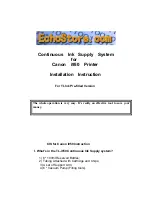
bRAKe liGht SolUtionS
with
an optional Brake-Lite Relay.
(This method cannot be used in Ford vehicles with
‘neutral tow’ kits. See “Ford ‘neutral tow’ vehicles,” in
these instructions.)
b.
Install a “bulb and socket set” (also called a “taillight
wiring kit,” part number 155).
c.
Install a magnetic tow light system (part number
2100 or 2120).
2. if the brake lights illuminate and the
towed vehicle has separate lighting…
…one of the four alternatives below is required.
A.
A system of diodes (the vehicle’s turn signals, tail-
lights and brake lights have been rewired for towing)
with
an optional Brake-Lite Relay.
(This method cannot be used in Ford vehicles with
‘neutral tow’ kits. See “Ford ‘neutral tow’ vehicles,” in
these instructions.)
b.
A system of diodes
with the diodes jumped
. This
method is also used to wire Ford vehicles with ‘neutral
tow’ kits. See Figure 21.
c.
Install a “bulb and socket set” (also called a “taillight
wiring kit,” part number 155).
D.
Install a magnetic tow light system (part number
2100 or 2120).
3. if the brake lights do not illuminate…
…an optional stop light switch
must
be installed.
ROADMASTER manufactures stop light switch kits for
a number of vehicles; visit www.roadmasterinc.com and
select ‘Vehicle-Specific Info,’ enter the vehicle make,
model and year, then select ‘Braking Systems’ and
scroll down the page.
Any one of the following tow lighting systems must
also be installed with the stop light switch:
• a system of diodes (the vehicle’s turn signals, tail-
lights and brake lights have been rewired for towing)
• a “bulb and socket set” (also called a “taillight
wiring kit,” part number 155)
• a magnetic tow light system (part number 2100 or
2120)
figure 19
A supplemental braking system will affect the op-
eration of the vehicle’s tow lighting system. Use the
information below to determine if optional accessories
must be installed in a vehicle which has been wired for
towing — or, if no lighting system has been installed,
which systems are appropriate.
1.
First, identify the type of brake and turn signals in
the vehicle. There are two types — combined or sep-
arate. In a
combined
system (Figure 19), the brake
light does the flashing for the turn signal; in a
separate
system (Figure 19), there are amber or red turn signal
lights which are separate from the brake lights.
2.
Next, test to see if the towed vehicle’s brake lights
will illuminate with the engine off — turn the ignition key
to the “tow” position, press the brake pedal, and check
the brake lights.
3.
Based on whether or not the brake lights illuminate,
and the type of brake and turn signals, there are three
possibilities:
1) the brake lights illuminate and the towed vehicle
has combined lighting;
2) the brake lights illuminate and the towed vehicle
has separate lighting; or
3) the brake lights do not illuminate.
Choose from the appropriate list below to install
either an optional accessory or another lighting system.
(If you choose to install a Brake-Lite Relay, a taillight
wiring kit or magnetic lights, the installation instructions
are included with the kits. If you choose to install a
system of diodes and rewire the vehicle’s turn signals,
taillights and brake lights for towing, wiring diagrams
are available online, at www.roadmasterinc.com.)
1. if the brake lights illuminate and the
towed vehicle has combined lighting…
…one of the three alternatives below is required.
A.
A system of diodes (the vehicle’s turn signals, tail-
lights and brake lights have been rewired for towing)
16
Summary of Contents for BrakeMaster 9100
Page 4: ...2...







































